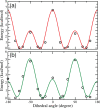Probing Liquid-Ordered and Disordered Phases in Lipid Model Membranes: A Combined Theoretical and Spectroscopic Study of a Fluorescent Molecular Rotor
- PMID: 35001625
- PMCID: PMC8785181
- DOI: 10.1021/acs.jpcb.1c08324
Probing Liquid-Ordered and Disordered Phases in Lipid Model Membranes: A Combined Theoretical and Spectroscopic Study of a Fluorescent Molecular Rotor
Abstract
An integrated theoretical/experimental strategy has been applied to the study of environmental effects on the spectroscopic parameters of 4-(diphenylamino)phtalonitrile (DPAP), a fluorescent molecular rotor. The computational part starts from the development of an effective force field for the first excited electronic state of DPAP and proceeds through molecular dynamics simulations in solvents of different polarities toward the evaluation of Stokes shifts by quantum mechanics/molecular mechanics (QM/MM) approaches. The trends of the computed results closely parallel the available experimental results thus giving confidence to the interpretation of new experimental studies of the photophysics of DPAP in lipid bilayers. In this context, results show unambiguously that both flexible dihedral angles and global rotations are significantly retarded in a cholesterol/DPPC lipid matrix with respect to the DOPC matrix, thus confirming the sensitivity of DPAP to probe different environments and, therefore, its applicability as a probe for detecting different structures and levels of plasma membrane organization.
Conflict of interest statement
The authors declare no competing financial interest.
Figures








Similar articles
-
Atomistic simulation of cholesterol effects on miscibility of saturated and unsaturated phospholipids: implications for liquid-ordered/liquid-disordered phase coexistence.J Am Chem Soc. 2011 Mar 16;133(10):3625-34. doi: 10.1021/ja110425s. Epub 2011 Feb 22. J Am Chem Soc. 2011. PMID: 21341653
-
Orientation of Laurdan in Phospholipid Bilayers Influences Its Fluorescence: Quantum Mechanics and Classical Molecular Dynamics Study.Molecules. 2018 Jul 13;23(7):1707. doi: 10.3390/molecules23071707. Molecules. 2018. PMID: 30011800 Free PMC article.
-
Di-8-ANEPPS emission spectra in phospholipid/cholesterol membranes: a theoretical study.J Phys Chem B. 2011 Apr 14;115(14):4160-7. doi: 10.1021/jp1111372. Epub 2011 Mar 22. J Phys Chem B. 2011. PMID: 21425824
-
The fluorescent cholesterol analog dehydroergosterol induces liquid-ordered domains in model membranes.Chem Phys Lipids. 2009 Jun;159(2):114-8. doi: 10.1016/j.chemphyslip.2009.03.002. Epub 2009 Mar 28. Chem Phys Lipids. 2009. PMID: 19477318
-
Photophysics in Biomembranes: Computational Insight into the Interaction between Lipid Bilayers and Chromophores.Acc Chem Res. 2024 Aug 20;57(16):2245-2254. doi: 10.1021/acs.accounts.4c00153. Epub 2024 Aug 6. Acc Chem Res. 2024. PMID: 39105728 Free PMC article. Review.
References
MeSH terms
Substances
LinkOut - more resources
Full Text Sources

